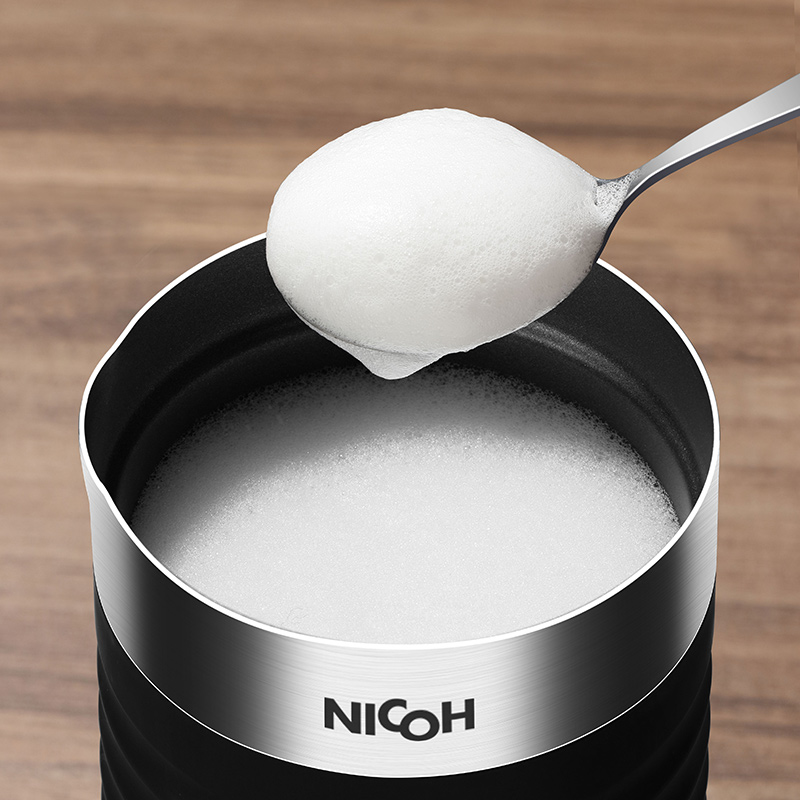About us
- Hotline -+86-139-2434-9648

Milk frother Common problems and solutions for milk froth
What does the degree of fusion between milk foam and milk depend on? The degree of fusion mainly depends on the following two points:
1. The pressure of the steam rod. (The pressure of the steam rod will cause the milk foam to roll to different degrees during the process of beating. The higher the pressure, the higher the degree of fusion.)
2. The exquisite degree of milk foam. (The finer the foamed milk foam, the less air contained in a single milk foam, the higher the density, and the lower the buoyancy; the rougher the foamed milk foam, the more air contained in the single milk foam, the lower the density and the greater the buoyancy. . If the milk froth is rough, the milk froth will float on the milk surface quickly and the degree of fusion will be low; if the milk froth is more delicate, the milk froth will float slowly on the milk surface and the degree of fusion will be higher.)
Reason for failure: Is your milk froth temperature too high?
Heat the milk to about 60 degrees, but not more than 70 degrees, otherwise the protein structure in the milk will be destroyed.
Four reasons for failure: Is the degree of fusion between milk froth and milk sufficient?
The higher the degree of fusion between milk froth and milk, the clearer and more delicate the garland pattern lines will be; on the contrary, the garland pattern lines will be blurry and rougher.
Reason for failure: Is your concentrated fat enough?
The Espresso used as the base has sufficient concentration. For the beans, use medium-deep roasted or deep roasted beans, and there should be a layer of fat foam floating on it.
Reason for failure: Was the drawing action correct?
The starting action of the garland is to shake the wrist holding the garland cup from side to side. The focus of fusion is to steadily sway the wrist horizontally from side to side. Please note that this movement only requires the strength of the wrist, not the entire arm. They all move together, and when the shaking is correct, patterns will begin to appear in the cup.
Reason for failure: Is the milk froth too thin? Not delicate enough?
The milk foam should not be too thick. Too thick will cause a lot of white milk foam in the pull cup before it is opened, and the milk foam should not be too thin. If it is too thin, it will not be able to draw a decent pattern.

The fineness of the milk froth is very important for the garland. The finer the milk froth is, the less air is contained in the single milk froth, the higher the density, and the lower the buoyancy; the rougher the milk froth, the more The more air contained in a single milk foam, the lower the density and the greater the buoyancy. If the milk foam is rough, the milk foam will quickly float on the milk surface and the degree of fusion will be low; if the milk foam is more delicate, the milk foam will float slowly on the milk surface and the degree of fusion will be higher.
3. How can I mix the milk well?
It's milk and milk foam. How can we mix it well? When the flower is drawn, it won't be completely white when it falls down? Temperature,,, and temperature are very important. When you are frothing the milk, put your free hand on the draw cup to feel the temperature of the milk,
It's almost fine when you feel that your hands are very hot and you can no longer continue to put it on the garland. If you continue to beat it, the milk froth will be too hard. Hard milk froth looks very stiff. When you pour the milk froth into the coffee, it will not mix with the coffee, but will pile up on your coffee like fluffy whipped cream. If it is beaten a little longer, it will layer, 90% of it is running milk, and a thick hard milk froth cover floating on it. When you pour the coffee into the coffee, the milk will flow out of the garland cup first. So, if the milk and milk froth are mixed well, temperature is the key. After the milk froth is beaten, the time can not be left too long, otherwise it will be layered.
4. How can I make milk foam with more and fine texture?
About how to make a good milk froth, here is a fool's milk froth method, which is to pour half of the milk into the steel cup, make the steam tube and the milk perpendicular to the center or the edge of the steel cup, and then let The steam head just touches the surface of the milk, then open the steam to 1/2 point, do not move the steel cup, slowly close when the milk reaches 50 degrees, just close at 60 degrees, and finally the temperature will reach 66 degrees, so you can shoot A cup of good milk froth,
5. Which type of Italian machine should I use for milk frothing?
Generally, there are three, four, and five-hole steam heads for general machines. As long as you are familiar with it, you can make good milk foam. However, the machine, the amount of steam, the degree of wetness and dryness of the steam, and the size of the pores still have an effect on milking.
6. Why do we need to practice milk frothing with water?
First, everyone knows that water is transparent, allowing you to see more clearly how the vortex is formed.
The second is to be able to better grasp the method of playing milk foam with different holes! The third is to remember that when you are not able to beat the milk foam to a thin, you should use a thermometer. The temperature cannot be better controlled. The coffee you make is unstable. You may foam milk once or twice in ten times, but that is not a stable quality.
7. The difference between steam milking and manual milking
First of all, the hand-beaten milk froth can't compare with the steam of the machine. The delicacy of the steam makes the milk froth very delicate and smooth, and the radiant surface of the steam is wide. The milk froth will be more uniform and mixed better. The hand beater is mainly squeezed through the small holes of the filter, and the beaten milk foam is relatively thick.
phone
Tel
mobile app
